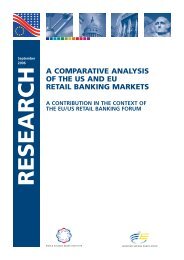Corporate Governance and Access to Finance - ESBG
Corporate Governance and Access to Finance - ESBG
Corporate Governance and Access to Finance - ESBG
You also want an ePaper? Increase the reach of your titles
YUMPU automatically turns print PDFs into web optimized ePapers that Google loves.
For example, in Latin America, WSBI members are long-established providersof microfinance services (both savings <strong>and</strong> credits); in Africa they havetraditionally provided microsavings; in Asia they act as formalmicrofinance providers in different forms (as development banks, savingsinstitutions, postal banks <strong>and</strong> retail banks); <strong>and</strong> in Europe microcredit hasreceived recognition in recent years (see WSBI, Perspectives 59).Focusing on households as consumers of financial products, Honohan(2008) finds that a regula<strong>to</strong>ry design for microfinance institutions <strong>to</strong>ensure consumer protection does not impose costs in a marketcharacterized by low margins. His research shows that facilitating access<strong>to</strong> financial services such as transactions accounts, or savings accounts,loans from a formal intermediary or insurance policy can reduce poverty.A regula<strong>to</strong>ry environment protecting stakeholders does not seem <strong>to</strong> be arestriction for the entry of new banking institutions. The positiveexpected returns related <strong>to</strong> the improvement in <strong>Access</strong> <strong>to</strong> <strong>Finance</strong> seem<strong>to</strong> prevail over the costs of the regula<strong>to</strong>ry restrictions.The literature does not favor any specific ownership type in microfinanceorganizations in terms of reducing costs. Mersl<strong>and</strong> (2009) compares thecosts of a variety of microfinance institutions including member-basedcooperatives, non-profit organizations or shareholder firms. These costsrefer <strong>to</strong> (i) the ones derived from limited market competition, (ii) “lock-in”costs due <strong>to</strong> a single credit provider, (iii) costs related <strong>to</strong> asymmetricinformation of borrowers <strong>and</strong> credit institutions, (iv) cost of access <strong>to</strong>equity capital <strong>and</strong> (v) cost of moni<strong>to</strong>ring managers. The findings showthat diversity pays: a mixture of different ownership types in the financialsystem, similar <strong>to</strong> that found in mature banking markets, best servesmicrofinance cus<strong>to</strong>mers. This ownership typology is similar, <strong>to</strong> someextent, <strong>to</strong> the diversity of WSBI members, including many different typesof stakeholders. The conclusion is that no ownership structure type, norstakeholder composition, dominates the others, based on the expectedreduction of the mentioned costs as a yardstick. These conjectures wereempirically supported by Mersl<strong>and</strong> & Strøm (2008), accounting for sixspecific performance aspects of financial access: cost, depth, breadth,length, scope <strong>and</strong> worth.This kind of evidence shows that it is possible <strong>to</strong> satisfy the needs ofdifferent types of stakeholders <strong>and</strong> providing profitable financial serviceswith diverse ownership structures of banking institutions.107
















